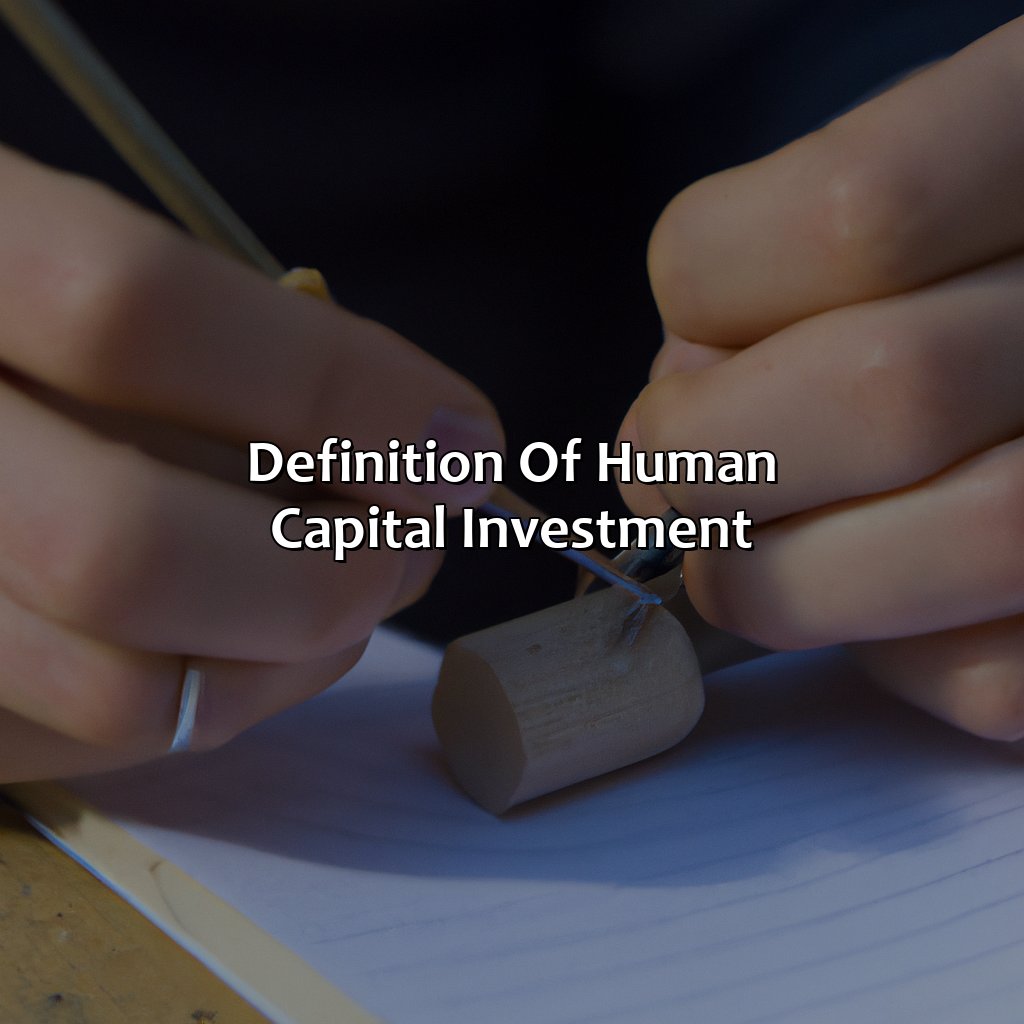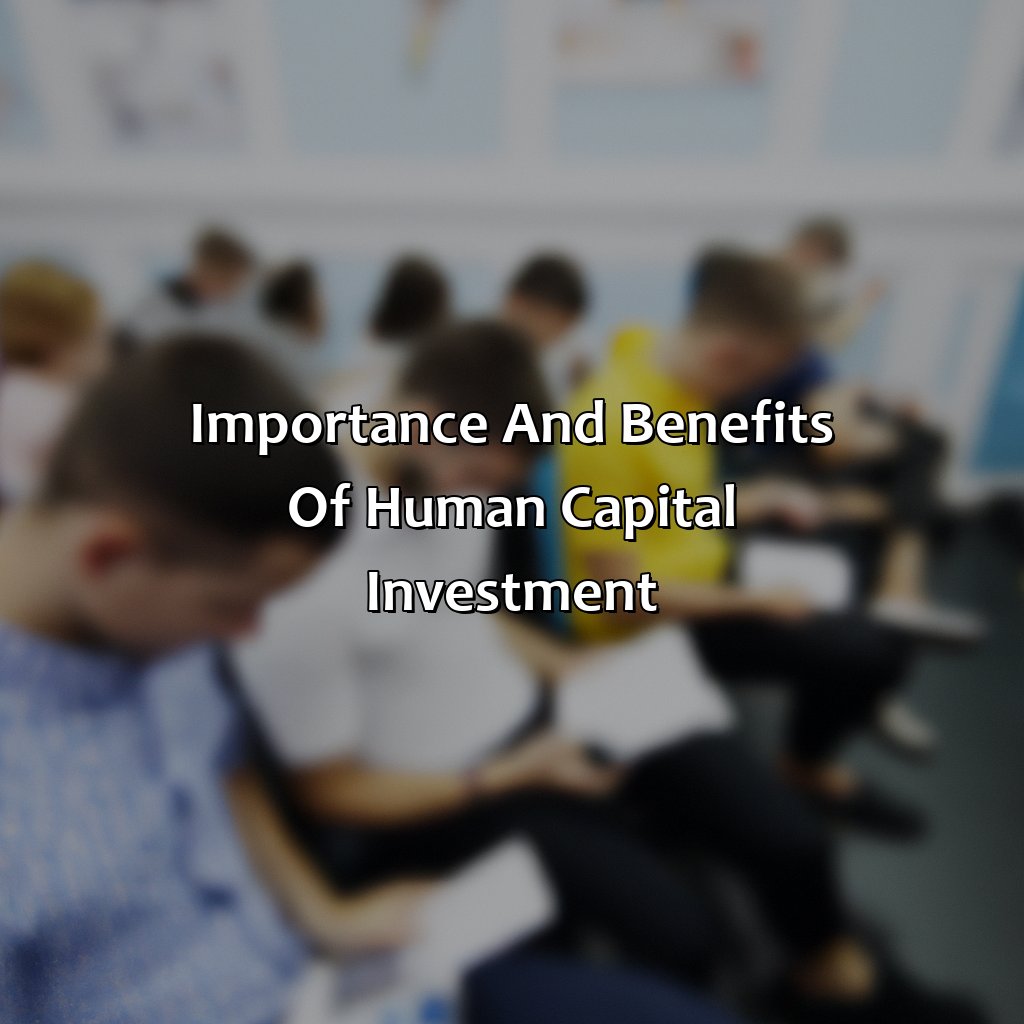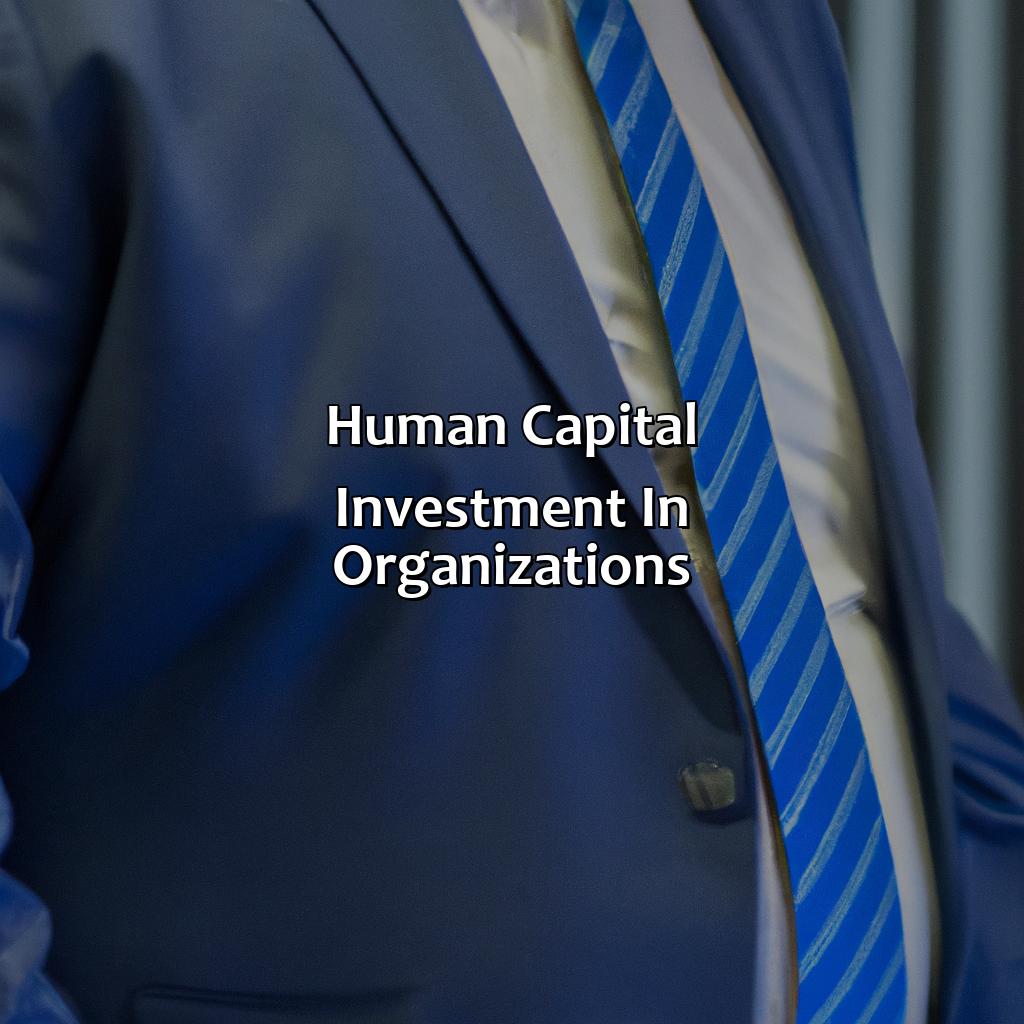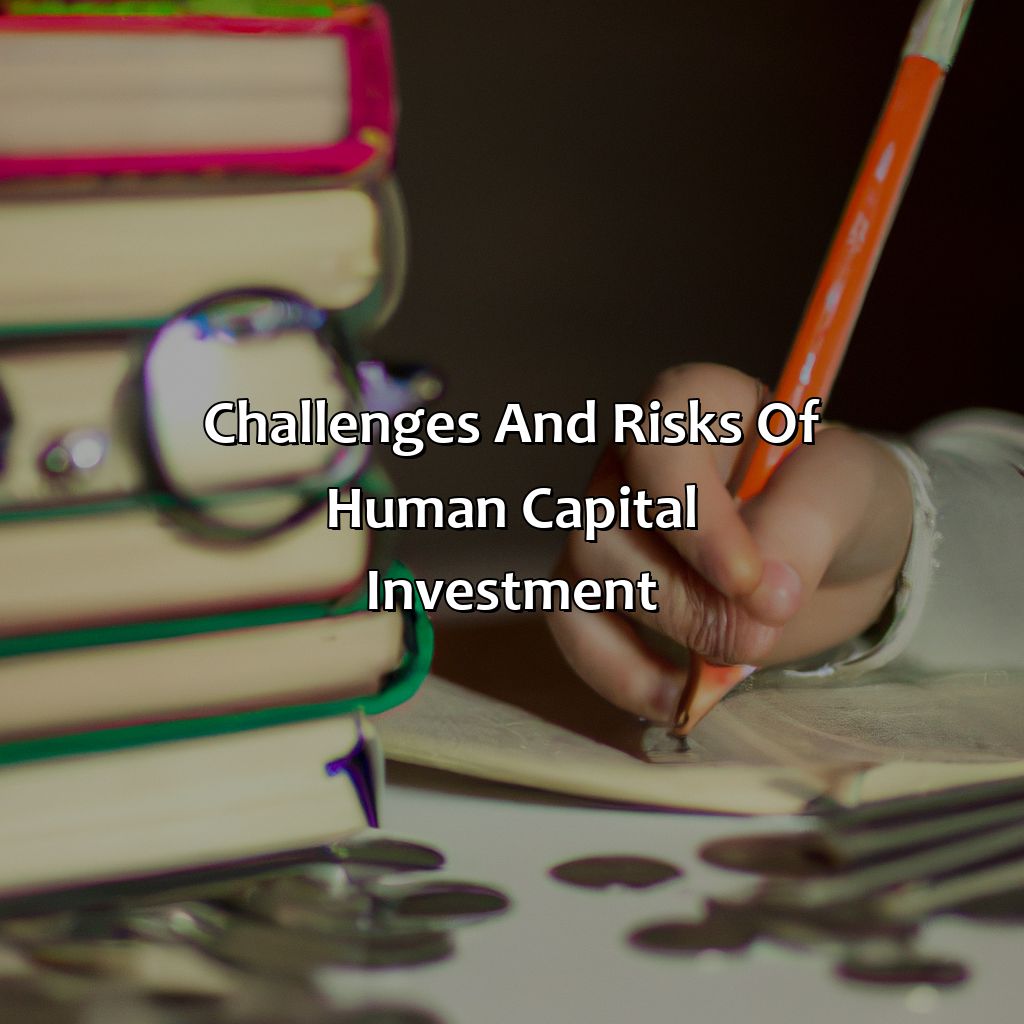What Is Investment In Human Capital?
Key Takeaway:
- Human capital investment refers to the development and enhancement of an individual’s skills, knowledge, and abilities to increase their productivity and value to an organization.
- Investing in human capital can yield many benefits such as improved job performance, increased innovation and creativity, higher employee retention rates, and greater overall organizational success.
- To effectively invest in human capital, organizations can provide opportunities for education and training, skill development, experience and exposure, health and wellness programs, and embrace diversity and inclusion.
Do you want to make your money work for you? Investing in human capital is a great way to do that. This article will explain what human capital is, how it works, and why it is an important investment. You’ll learn how to maximize the returns from investing in yourself.
Definition of human capital investment
Investment in human capital refers to the deliberate act of allocating resources towards the development of skills, knowledge, and abilities of individuals. This investment can take various forms such as education, training, and healthcare. The primary objective of human capital investment is to improve the productivity and efficiency of human resources, thereby enhancing economic growth and development. Human capital investment is essential in a rapidly changing technological world, where new skills and knowledge are required to remain competitive.
Human capital investment is not limited to just formal education and training programs. It can also include on-the-job training, attendance at professional conferences, and even investing in one’s physical and mental health. The benefits of investing in human capital are numerous, including increased career opportunities, improved job performance, and higher wages or salaries.
Although the concept of human capital investment is relatively new, humans have been investing in their own development for centuries. Historical examples can include apprenticeships in the trades, individual or family funding for education, and the development of specialized skills in early industries. With the rise of the knowledge economy, we continue to see the importance of human capital investment as a means of staying competitive and adapting to changing market demands.

Image credits: retiregenz.com by Joel Woodhock
Importance and benefits of human capital investment
Human capital investment is crucial for both the individual and organizations as it enhances the knowledge, skills and abilities of an employee. It leads to improved productivity, job satisfaction, and career advancement. Investing in human capital also ensures a workforce that adapts to changing technology and work practices.
Moreover, human capital investment also leads to a significant increase in job security and employee retention. It creates a positive organizational culture that encourages learning, growth, and development. By investing in employees, companies can reduce their recruitment costs and improve their bottom line.
Interestingly, a study by the American Society for Training and Development highlighted that organizations that invest in their human capital have a 24% higher profit margin compared to organizations that don’t invest in employee development.
Source: https://go.iu.edu/2B5B

Image credits: retiregenz.com by David Duncun
Ways to invest in human capital
Investing in Human Capital: Strategies for Growth
To effectively invest in human capital, a company must first identify key areas where capital can be infused. Research shows that employee training, development programs, and continuous education are some of the most effective ways to invest in human capital. Providing regular feedback and performance evaluations, creating a healthy work environment, offering competitive benefits, and promoting diversity and inclusion are also important tactics.
It’s crucial for businesses to identify areas of growth and implement corresponding human capital investments. Additionally, leaders should continuously measure and evaluate success to identify areas that require improvement. Only by understanding individual strengths and weaknesses can one optimize this investment and ensure employee satisfaction and retention.
Historically, companies that have invested in human capital have seen significant returns, including increased productivity, a competitive edge, and revenue growth. One notable example is Apple, which created an extensive employee training program in the 1990s that prioritized the development of soft skills, or interpersonal abilities like communication and teamwork. This initiative helped fuel the company’s rapid expansion and solidified its reputation as a leading tech innovator.
Ultimately, investing in human capital is critical for businesses wanting to stay ahead of the curve. By prioritizing employee development and fostering a positive work environment, companies can boost productivity, retain top talent, and succeed in a rapidly changing business landscape.

Image credits: retiregenz.com by Joel Woodhock
Human Capital Investment in Organizations
Investing in the knowledge, skills, and abilities of employees, also known as human capital investment, is crucial for the growth and development of organizations. Such investments can be in the form of training, education, or providing resources to enhance employee productivity and contribution to the company’s success. Besides improving individual performance, human capital investment facilitates better teamwork, communication, and problem-solving within the organization.
Organizations that prioritize human capital investment often create a positive work culture, resulting in higher employee retention rates and attracting top talent. Investing in human capital ensures that employees are equipped with the latest technology and tools, which increases efficiency and effectiveness. The positive results of investing in human capital can translate into higher profitability and a competitive edge for organizations in the long run.
In addition to training and education, organizations can invest in employee benefits such as health insurance, retirement plans, and work-life balance initiatives. Such investments in employees’ wellbeing improve their job satisfaction and, in turn, increase employee engagement and productivity.
Pro Tip: Make human capital investment an ongoing process rather than a one-time event. Prioritize employee development as an essential part of the organization’s culture and create a supportive environment that fosters continuous learning and growth.

Image credits: retiregenz.com by Harry Washington
Challenges and Risks of human capital investment
Human capital investment entails various challenges and risks that must be considered before investing resources in individuals. These possible risks stem from the inherent uncertainty of investing in people, including the inability to foresee their future performance accurately, the possibility of an individual departing the organization before any returns can be realized, and the likelihood of investing in the wrong skills or capabilities.
Furthermore, investing in human capital may not guarantee an increase in productivity or profits. Inadequate training programs or the lack of a well-defined career progression path could result in employees being disengaged or leaving the organization. Insufficient feedback mechanisms can also limit an individual’s growth and lead to negative consequences for the organization.
To mitigate these risks, organizations must invest in an effective selection process that aligns an individual’s goals with those of the organization. Training programs should be tailored to individual needs while paying attention to the dynamic nature of the industry and the skill sets necessary to remain competitive. Performance management systems should be implemented to provide continuous feedback for improvement to ensure employees remain motivated.
In essence, organizations must not only invest financial resources in their employees but must also commit to providing positive work environments, such as professional development opportunities, and rewards that are commensurate with the employee’s efforts to stimulate engagement and retention.

Image credits: retiregenz.com by Harry Woodhock
Five Facts About Investment in Human Capital:
Investment in human capital refers to the process of improving knowledge, skills, and abilities of individuals through various means, such as education, training, and experience. (Source: World Bank)
Investment in human capital is essential for economic growth, as it plays a vital role in increasing productivity, innovation, and competitiveness of individuals and firms. (Source: OECD)
Investment in human capital can have positive social and health effects, as it can improve mental health, reduce poverty, and promote gender equality. (Source: UNDP)
Investment in human capital can have long-term benefits, such as higher wages, better job prospects, and improved standard of living. (Source: Federal Reserve Bank of St. Louis)
Investment in human capital is a continuous process and requires ongoing efforts to maintain and improve knowledge, skills, and abilities. (Source: Harvard Business Review)
FAQs about What Is Investment In Human Capital?
What is investment in human capital?
Investment in human capital refers to the process of enhancing an individual’s skills, knowledge, and abilities in order to improve their economic productivity and overall quality of life. This can be achieved through education, training, apprenticeships, and other forms of skill-building activities.
Why is investment in human capital important?
Investment in human capital is important because it contributes to a more skilled and productive workforce, which in turn leads to economic growth and development. It also allows individuals to achieve greater success and fulfillment in their careers and personal lives.
What are some examples of investment in human capital?
Examples of investment in human capital include enrolling in a college or university, attending a vocational training program, participating in an apprenticeship, attending conferences or workshops to learn new skills, and pursuing advanced degrees or certifications in a specific field.
How does investment in human capital benefit businesses?
Investment in human capital benefits businesses by providing them with a more skilled and knowledgeable workforce, which can increase productivity, efficiency, and profitability. It also contributes to employee satisfaction and retention, as individuals feel valued and invested in by their employers.
What are some potential drawbacks of investment in human capital?
One potential drawback of investment in human capital is the cost associated with providing education and training programs. Additionally, there is always the risk that individuals may take their newly acquired skills and knowledge to competitors or other employers, reducing the return on investment for the original company.
What is the long-term impact of investment in human capital?
The long-term impact of investment in human capital can be significant, as it can lead to increased innovation, competitiveness, and economic growth. As individuals become more skilled and knowledgeable, they are able to create new products and services, improve existing ones, and contribute to the overall betterment of society.
 Checkout this IRS Loophole
Checkout this IRS Loophole 
